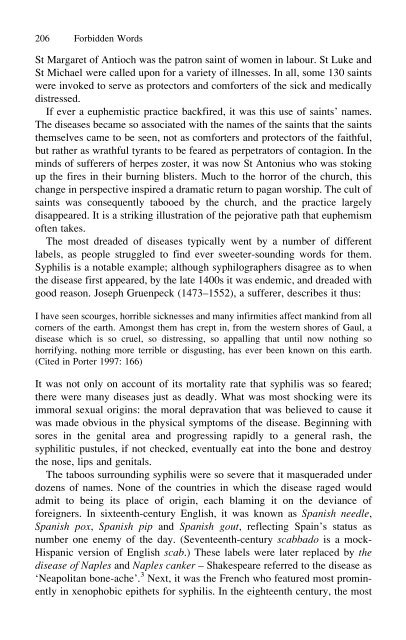Forbidden Words: Taboo and the Censoring of Language
Forbidden Words: Taboo and the Censoring of Language
Forbidden Words: Taboo and the Censoring of Language
You also want an ePaper? Increase the reach of your titles
YUMPU automatically turns print PDFs into web optimized ePapers that Google loves.
206 <strong>Forbidden</strong> <strong>Words</strong><br />
St Margaret <strong>of</strong> Antioch was <strong>the</strong> patron saint <strong>of</strong> women in labour. St Luke <strong>and</strong><br />
St Michael were called upon for a variety <strong>of</strong> illnesses. In all, some 130 saints<br />
were invoked to serve as protectors <strong>and</strong> comforters <strong>of</strong> <strong>the</strong> sick <strong>and</strong> medically<br />
distressed.<br />
If ever a euphemistic practice backfired, it was this use <strong>of</strong> saints’ names.<br />
The diseases became so associated with <strong>the</strong> names <strong>of</strong> <strong>the</strong> saints that <strong>the</strong> saints<br />
<strong>the</strong>mselves came to be seen, not as comforters <strong>and</strong> protectors <strong>of</strong> <strong>the</strong> faithful,<br />
but ra<strong>the</strong>r as wrathful tyrants to be feared as perpetrators <strong>of</strong> contagion. In <strong>the</strong><br />
minds <strong>of</strong> sufferers <strong>of</strong> herpes zoster, it was now St Antonius who was stoking<br />
up <strong>the</strong> fires in <strong>the</strong>ir burning blisters. Much to <strong>the</strong> horror <strong>of</strong> <strong>the</strong> church, this<br />
change in perspective inspired a dramatic return to pagan worship. The cult <strong>of</strong><br />
saints was consequently tabooed by <strong>the</strong> church, <strong>and</strong> <strong>the</strong> practice largely<br />
disappeared. It is a striking illustration <strong>of</strong> <strong>the</strong> pejorative path that euphemism<br />
<strong>of</strong>ten takes.<br />
The most dreaded <strong>of</strong> diseases typically went by a number <strong>of</strong> different<br />
labels, as people struggled to find ever sweeter-sounding words for <strong>the</strong>m.<br />
Syphilis is a notable example; although syphilographers disagree as to when<br />
<strong>the</strong> disease first appeared, by <strong>the</strong> late 1400s it was endemic, <strong>and</strong> dreaded with<br />
good reason. Joseph Gruenpeck (1473–1552), a sufferer, describes it thus:<br />
I have seen scourges, horrible sicknesses <strong>and</strong> many infirmities affect mankind from all<br />
corners <strong>of</strong> <strong>the</strong> earth. Amongst <strong>the</strong>m has crept in, from <strong>the</strong> western shores <strong>of</strong> Gaul, a<br />
disease which is so cruel, so distressing, so appalling that until now nothing so<br />
horrifying, nothing more terrible or disgusting, has ever been known on this earth.<br />
(Cited in Porter 1997: 166)<br />
It was not only on account <strong>of</strong> its mortality rate that syphilis was so feared;<br />
<strong>the</strong>re were many diseases just as deadly. What was most shocking were its<br />
immoral sexual origins: <strong>the</strong> moral depravation that was believed to cause it<br />
was made obvious in <strong>the</strong> physical symptoms <strong>of</strong> <strong>the</strong> disease. Beginning with<br />
sores in <strong>the</strong> genital area <strong>and</strong> progressing rapidly to a general rash, <strong>the</strong><br />
syphilitic pustules, if not checked, eventually eat into <strong>the</strong> bone <strong>and</strong> destroy<br />
<strong>the</strong> nose, lips <strong>and</strong> genitals.<br />
The taboos surrounding syphilis were so severe that it masqueraded under<br />
dozens <strong>of</strong> names. None <strong>of</strong> <strong>the</strong> countries in which <strong>the</strong> disease raged would<br />
admit to being its place <strong>of</strong> origin, each blaming it on <strong>the</strong> deviance <strong>of</strong><br />
foreigners. In sixteenth-century English, it was known as Spanish needle,<br />
Spanish pox, Spanish pip <strong>and</strong> Spanish gout, reflecting Spain’s status as<br />
number one enemy <strong>of</strong> <strong>the</strong> day. (Seventeenth-century scabbado is a mock-<br />
Hispanic version <strong>of</strong> English scab.) These labels were later replaced by <strong>the</strong><br />
disease <strong>of</strong> Naples <strong>and</strong> Naples canker – Shakespeare referred to <strong>the</strong> disease as<br />
‘Neapolitan bone-ache’. 3 Next, it was <strong>the</strong> French who featured most prominently<br />
in xenophobic epi<strong>the</strong>ts for syphilis. In <strong>the</strong> eighteenth century, <strong>the</strong> most

















